Venue Design Analysis Report: Entrepreneurship MNG00314 Assignment
VerifiedAdded on 2022/10/19
|12
|2650
|20
Report
AI Summary
This report provides a comprehensive analysis of a venue's design, specifically focusing on the reception area and lobby. The report begins by emphasizing the importance of design in shaping environments and experiences, highlighting the application of universal design principles to ensure accessibility and inclusivity for all users, regardless of their abilities or characteristics. The analysis delves into the practical application of these principles, examining factors such as equitable use, flexibility, simplicity, perceptible information, error tolerance, and low physical effort. The report then assesses the existing design, identifying areas for improvement in areas like lighting, flooring, and furniture to enhance the overall user experience. A key component of the report is the Venue Condition Assessment (VCA), which evaluates the venue's functionality and aesthetic capabilities to make informed decisions for improvements, maintenance, and future planning, and the importance of a well-designed reception area in creating a positive first impression. The report concludes with recommendations for management, emphasizing the need for adequate funding, continuous maintenance, and integration of sustainable design practices.
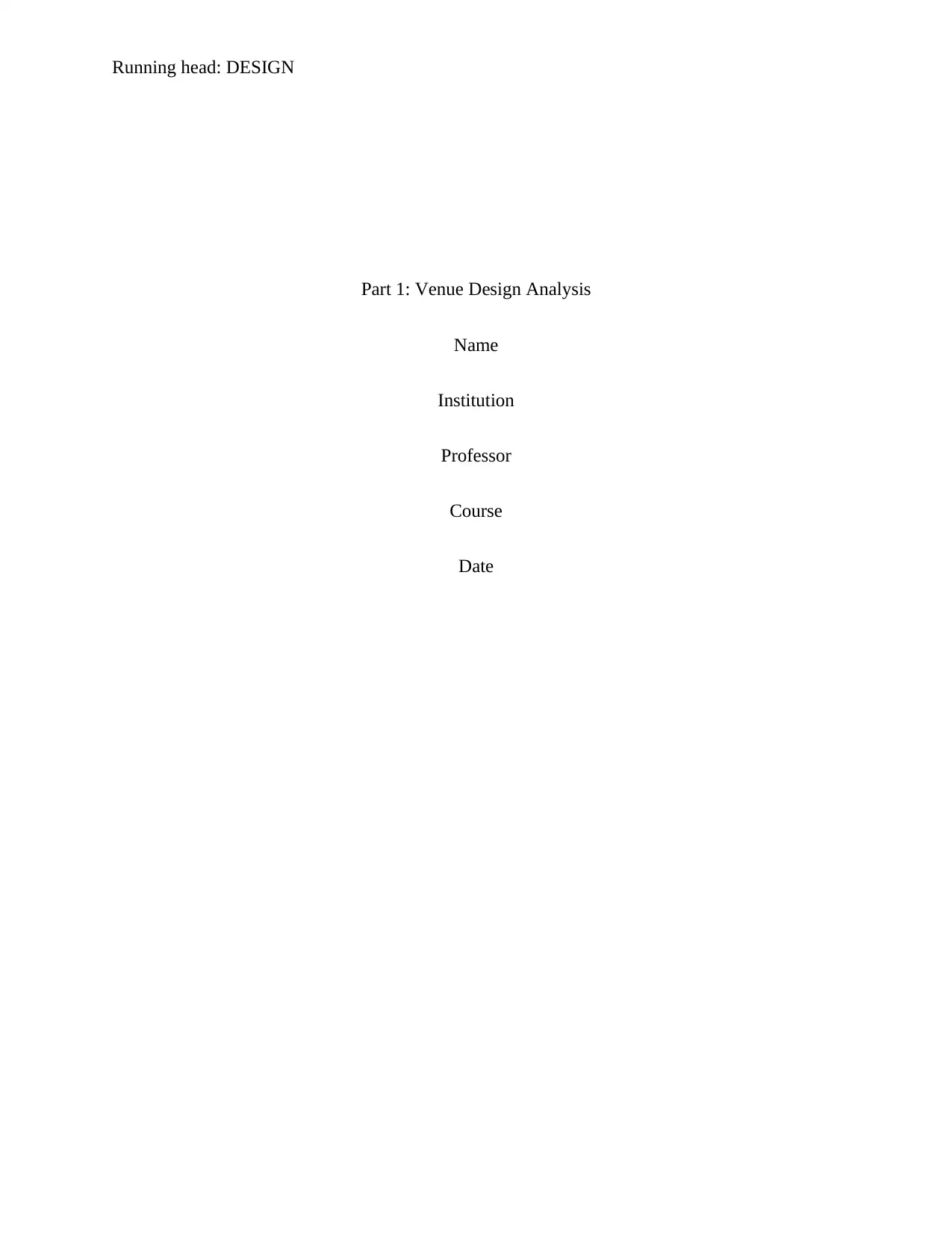
Running head: DESIGN
Part 1: Venue Design Analysis
Name
Institution
Professor
Course
Date
Part 1: Venue Design Analysis
Name
Institution
Professor
Course
Date
Paraphrase This Document
Need a fresh take? Get an instant paraphrase of this document with our AI Paraphraser
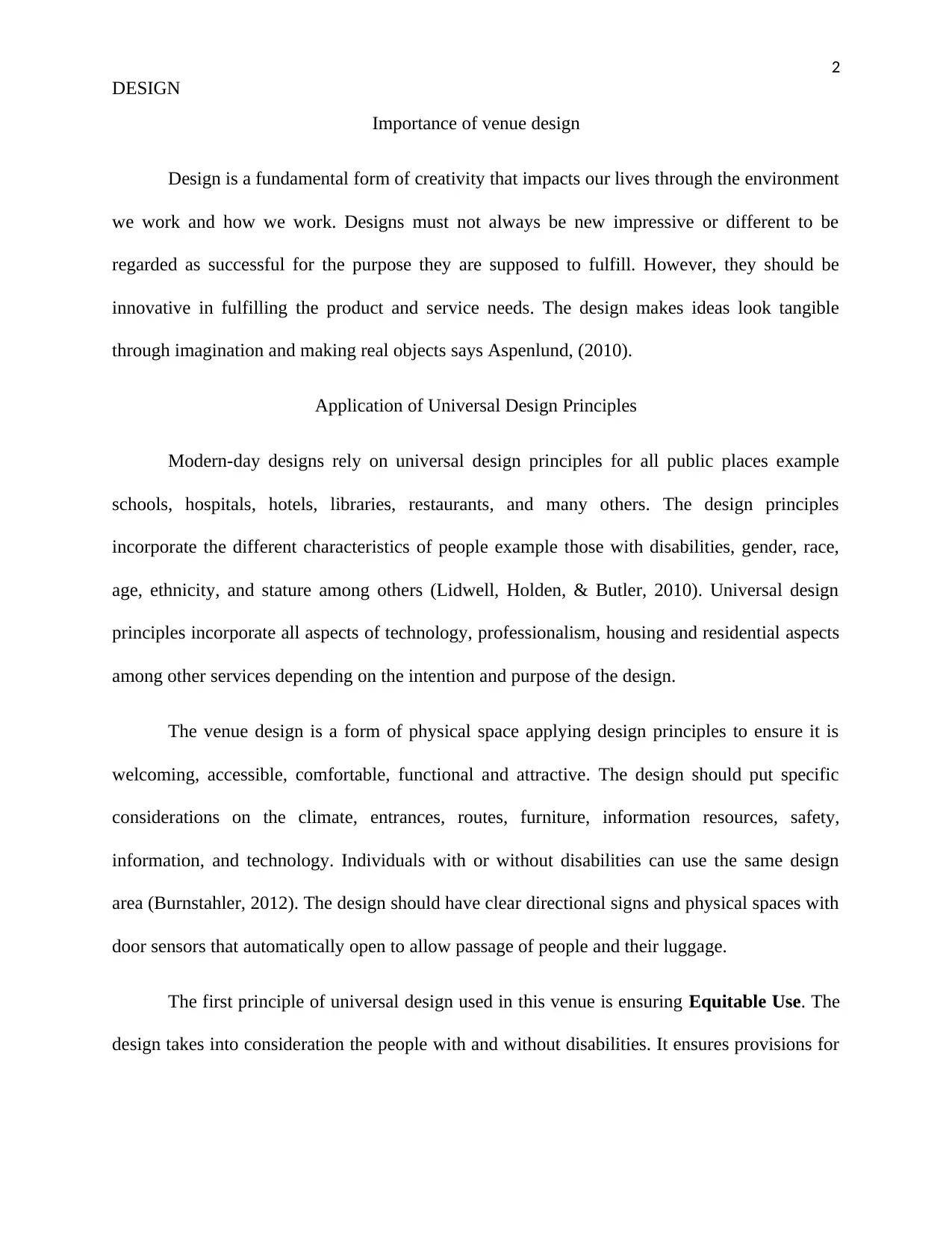
2
DESIGN
Importance of venue design
Design is a fundamental form of creativity that impacts our lives through the environment
we work and how we work. Designs must not always be new impressive or different to be
regarded as successful for the purpose they are supposed to fulfill. However, they should be
innovative in fulfilling the product and service needs. The design makes ideas look tangible
through imagination and making real objects says Aspenlund, (2010).
Application of Universal Design Principles
Modern-day designs rely on universal design principles for all public places example
schools, hospitals, hotels, libraries, restaurants, and many others. The design principles
incorporate the different characteristics of people example those with disabilities, gender, race,
age, ethnicity, and stature among others (Lidwell, Holden, & Butler, 2010). Universal design
principles incorporate all aspects of technology, professionalism, housing and residential aspects
among other services depending on the intention and purpose of the design.
The venue design is a form of physical space applying design principles to ensure it is
welcoming, accessible, comfortable, functional and attractive. The design should put specific
considerations on the climate, entrances, routes, furniture, information resources, safety,
information, and technology. Individuals with or without disabilities can use the same design
area (Burnstahler, 2012). The design should have clear directional signs and physical spaces with
door sensors that automatically open to allow passage of people and their luggage.
The first principle of universal design used in this venue is ensuring Equitable Use. The
design takes into consideration the people with and without disabilities. It ensures provisions for
DESIGN
Importance of venue design
Design is a fundamental form of creativity that impacts our lives through the environment
we work and how we work. Designs must not always be new impressive or different to be
regarded as successful for the purpose they are supposed to fulfill. However, they should be
innovative in fulfilling the product and service needs. The design makes ideas look tangible
through imagination and making real objects says Aspenlund, (2010).
Application of Universal Design Principles
Modern-day designs rely on universal design principles for all public places example
schools, hospitals, hotels, libraries, restaurants, and many others. The design principles
incorporate the different characteristics of people example those with disabilities, gender, race,
age, ethnicity, and stature among others (Lidwell, Holden, & Butler, 2010). Universal design
principles incorporate all aspects of technology, professionalism, housing and residential aspects
among other services depending on the intention and purpose of the design.
The venue design is a form of physical space applying design principles to ensure it is
welcoming, accessible, comfortable, functional and attractive. The design should put specific
considerations on the climate, entrances, routes, furniture, information resources, safety,
information, and technology. Individuals with or without disabilities can use the same design
area (Burnstahler, 2012). The design should have clear directional signs and physical spaces with
door sensors that automatically open to allow passage of people and their luggage.
The first principle of universal design used in this venue is ensuring Equitable Use. The
design takes into consideration the people with and without disabilities. It ensures provisions for
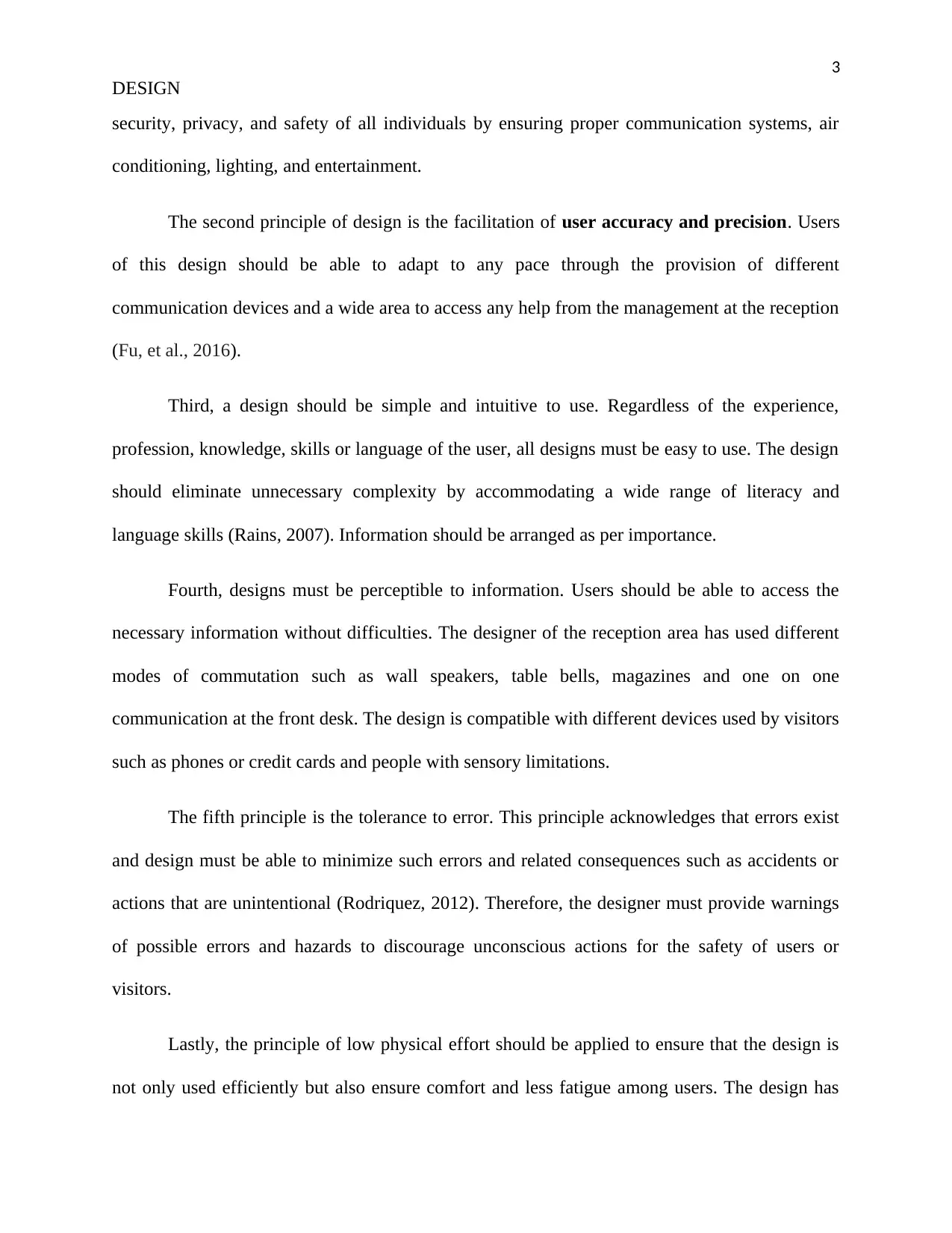
3
DESIGN
security, privacy, and safety of all individuals by ensuring proper communication systems, air
conditioning, lighting, and entertainment.
The second principle of design is the facilitation of user accuracy and precision. Users
of this design should be able to adapt to any pace through the provision of different
communication devices and a wide area to access any help from the management at the reception
(Fu, et al., 2016).
Third, a design should be simple and intuitive to use. Regardless of the experience,
profession, knowledge, skills or language of the user, all designs must be easy to use. The design
should eliminate unnecessary complexity by accommodating a wide range of literacy and
language skills (Rains, 2007). Information should be arranged as per importance.
Fourth, designs must be perceptible to information. Users should be able to access the
necessary information without difficulties. The designer of the reception area has used different
modes of commutation such as wall speakers, table bells, magazines and one on one
communication at the front desk. The design is compatible with different devices used by visitors
such as phones or credit cards and people with sensory limitations.
The fifth principle is the tolerance to error. This principle acknowledges that errors exist
and design must be able to minimize such errors and related consequences such as accidents or
actions that are unintentional (Rodriquez, 2012). Therefore, the designer must provide warnings
of possible errors and hazards to discourage unconscious actions for the safety of users or
visitors.
Lastly, the principle of low physical effort should be applied to ensure that the design is
not only used efficiently but also ensure comfort and less fatigue among users. The design has
DESIGN
security, privacy, and safety of all individuals by ensuring proper communication systems, air
conditioning, lighting, and entertainment.
The second principle of design is the facilitation of user accuracy and precision. Users
of this design should be able to adapt to any pace through the provision of different
communication devices and a wide area to access any help from the management at the reception
(Fu, et al., 2016).
Third, a design should be simple and intuitive to use. Regardless of the experience,
profession, knowledge, skills or language of the user, all designs must be easy to use. The design
should eliminate unnecessary complexity by accommodating a wide range of literacy and
language skills (Rains, 2007). Information should be arranged as per importance.
Fourth, designs must be perceptible to information. Users should be able to access the
necessary information without difficulties. The designer of the reception area has used different
modes of commutation such as wall speakers, table bells, magazines and one on one
communication at the front desk. The design is compatible with different devices used by visitors
such as phones or credit cards and people with sensory limitations.
The fifth principle is the tolerance to error. This principle acknowledges that errors exist
and design must be able to minimize such errors and related consequences such as accidents or
actions that are unintentional (Rodriquez, 2012). Therefore, the designer must provide warnings
of possible errors and hazards to discourage unconscious actions for the safety of users or
visitors.
Lastly, the principle of low physical effort should be applied to ensure that the design is
not only used efficiently but also ensure comfort and less fatigue among users. The design has
⊘ This is a preview!⊘
Do you want full access?
Subscribe today to unlock all pages.

Trusted by 1+ million students worldwide
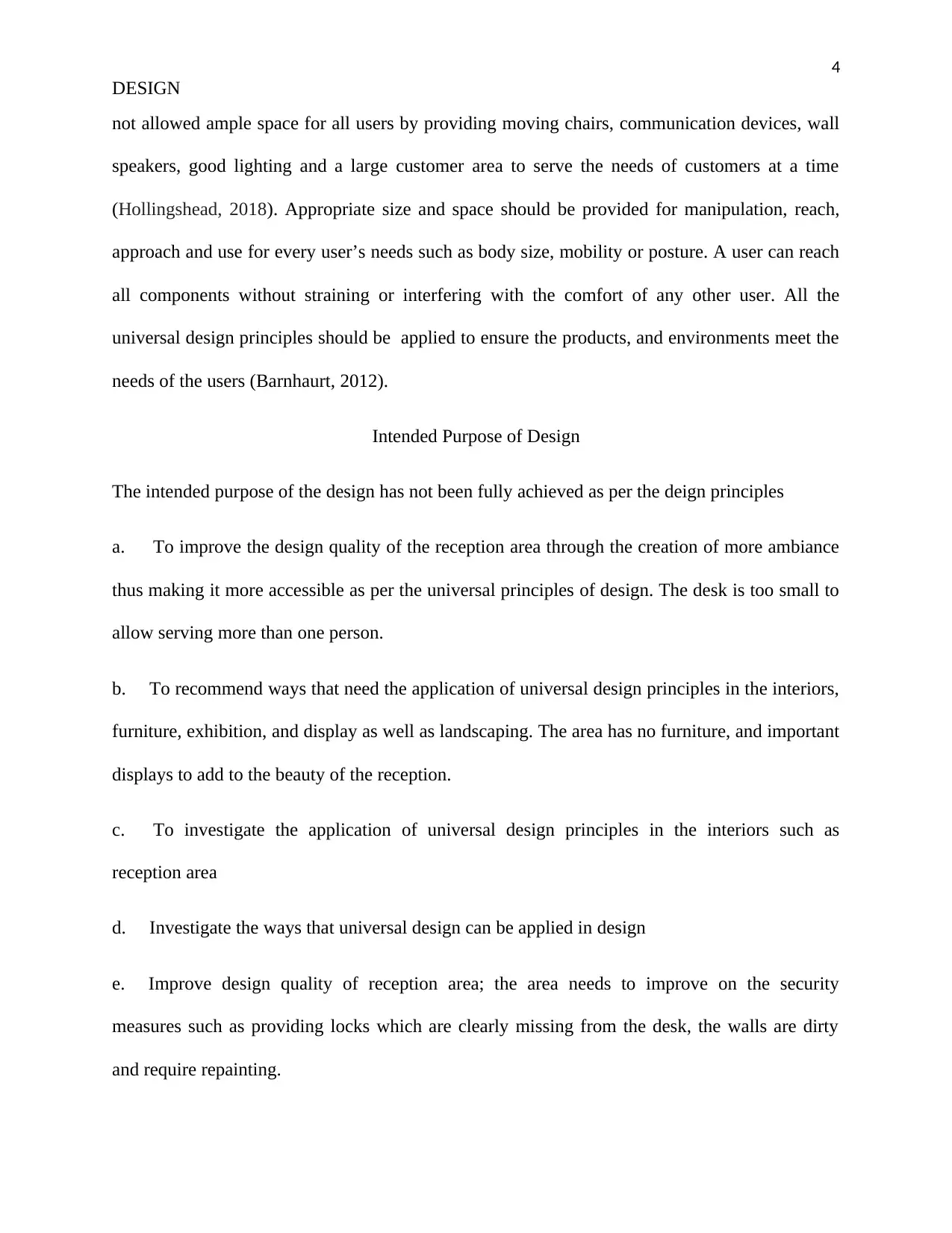
4
DESIGN
not allowed ample space for all users by providing moving chairs, communication devices, wall
speakers, good lighting and a large customer area to serve the needs of customers at a time
(Hollingshead, 2018). Appropriate size and space should be provided for manipulation, reach,
approach and use for every user’s needs such as body size, mobility or posture. A user can reach
all components without straining or interfering with the comfort of any other user. All the
universal design principles should be applied to ensure the products, and environments meet the
needs of the users (Barnhaurt, 2012).
Intended Purpose of Design
The intended purpose of the design has not been fully achieved as per the deign principles
a. To improve the design quality of the reception area through the creation of more ambiance
thus making it more accessible as per the universal principles of design. The desk is too small to
allow serving more than one person.
b. To recommend ways that need the application of universal design principles in the interiors,
furniture, exhibition, and display as well as landscaping. The area has no furniture, and important
displays to add to the beauty of the reception.
c. To investigate the application of universal design principles in the interiors such as
reception area
d. Investigate the ways that universal design can be applied in design
e. Improve design quality of reception area; the area needs to improve on the security
measures such as providing locks which are clearly missing from the desk, the walls are dirty
and require repainting.
DESIGN
not allowed ample space for all users by providing moving chairs, communication devices, wall
speakers, good lighting and a large customer area to serve the needs of customers at a time
(Hollingshead, 2018). Appropriate size and space should be provided for manipulation, reach,
approach and use for every user’s needs such as body size, mobility or posture. A user can reach
all components without straining or interfering with the comfort of any other user. All the
universal design principles should be applied to ensure the products, and environments meet the
needs of the users (Barnhaurt, 2012).
Intended Purpose of Design
The intended purpose of the design has not been fully achieved as per the deign principles
a. To improve the design quality of the reception area through the creation of more ambiance
thus making it more accessible as per the universal principles of design. The desk is too small to
allow serving more than one person.
b. To recommend ways that need the application of universal design principles in the interiors,
furniture, exhibition, and display as well as landscaping. The area has no furniture, and important
displays to add to the beauty of the reception.
c. To investigate the application of universal design principles in the interiors such as
reception area
d. Investigate the ways that universal design can be applied in design
e. Improve design quality of reception area; the area needs to improve on the security
measures such as providing locks which are clearly missing from the desk, the walls are dirty
and require repainting.
Paraphrase This Document
Need a fresh take? Get an instant paraphrase of this document with our AI Paraphraser
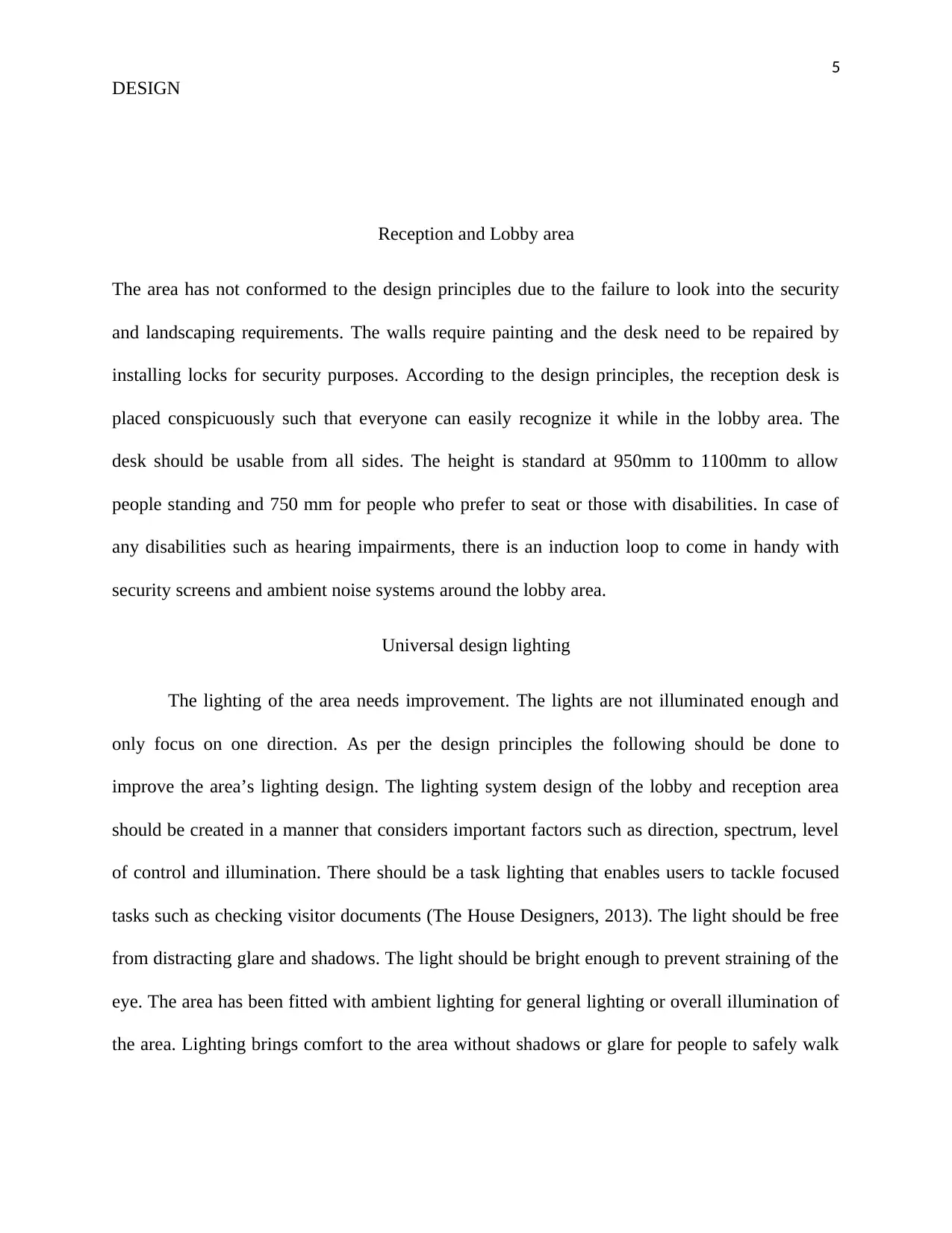
5
DESIGN
Reception and Lobby area
The area has not conformed to the design principles due to the failure to look into the security
and landscaping requirements. The walls require painting and the desk need to be repaired by
installing locks for security purposes. According to the design principles, the reception desk is
placed conspicuously such that everyone can easily recognize it while in the lobby area. The
desk should be usable from all sides. The height is standard at 950mm to 1100mm to allow
people standing and 750 mm for people who prefer to seat or those with disabilities. In case of
any disabilities such as hearing impairments, there is an induction loop to come in handy with
security screens and ambient noise systems around the lobby area.
Universal design lighting
The lighting of the area needs improvement. The lights are not illuminated enough and
only focus on one direction. As per the design principles the following should be done to
improve the area’s lighting design. The lighting system design of the lobby and reception area
should be created in a manner that considers important factors such as direction, spectrum, level
of control and illumination. There should be a task lighting that enables users to tackle focused
tasks such as checking visitor documents (The House Designers, 2013). The light should be free
from distracting glare and shadows. The light should be bright enough to prevent straining of the
eye. The area has been fitted with ambient lighting for general lighting or overall illumination of
the area. Lighting brings comfort to the area without shadows or glare for people to safely walk
DESIGN
Reception and Lobby area
The area has not conformed to the design principles due to the failure to look into the security
and landscaping requirements. The walls require painting and the desk need to be repaired by
installing locks for security purposes. According to the design principles, the reception desk is
placed conspicuously such that everyone can easily recognize it while in the lobby area. The
desk should be usable from all sides. The height is standard at 950mm to 1100mm to allow
people standing and 750 mm for people who prefer to seat or those with disabilities. In case of
any disabilities such as hearing impairments, there is an induction loop to come in handy with
security screens and ambient noise systems around the lobby area.
Universal design lighting
The lighting of the area needs improvement. The lights are not illuminated enough and
only focus on one direction. As per the design principles the following should be done to
improve the area’s lighting design. The lighting system design of the lobby and reception area
should be created in a manner that considers important factors such as direction, spectrum, level
of control and illumination. There should be a task lighting that enables users to tackle focused
tasks such as checking visitor documents (The House Designers, 2013). The light should be free
from distracting glare and shadows. The light should be bright enough to prevent straining of the
eye. The area has been fitted with ambient lighting for general lighting or overall illumination of
the area. Lighting brings comfort to the area without shadows or glare for people to safely walk
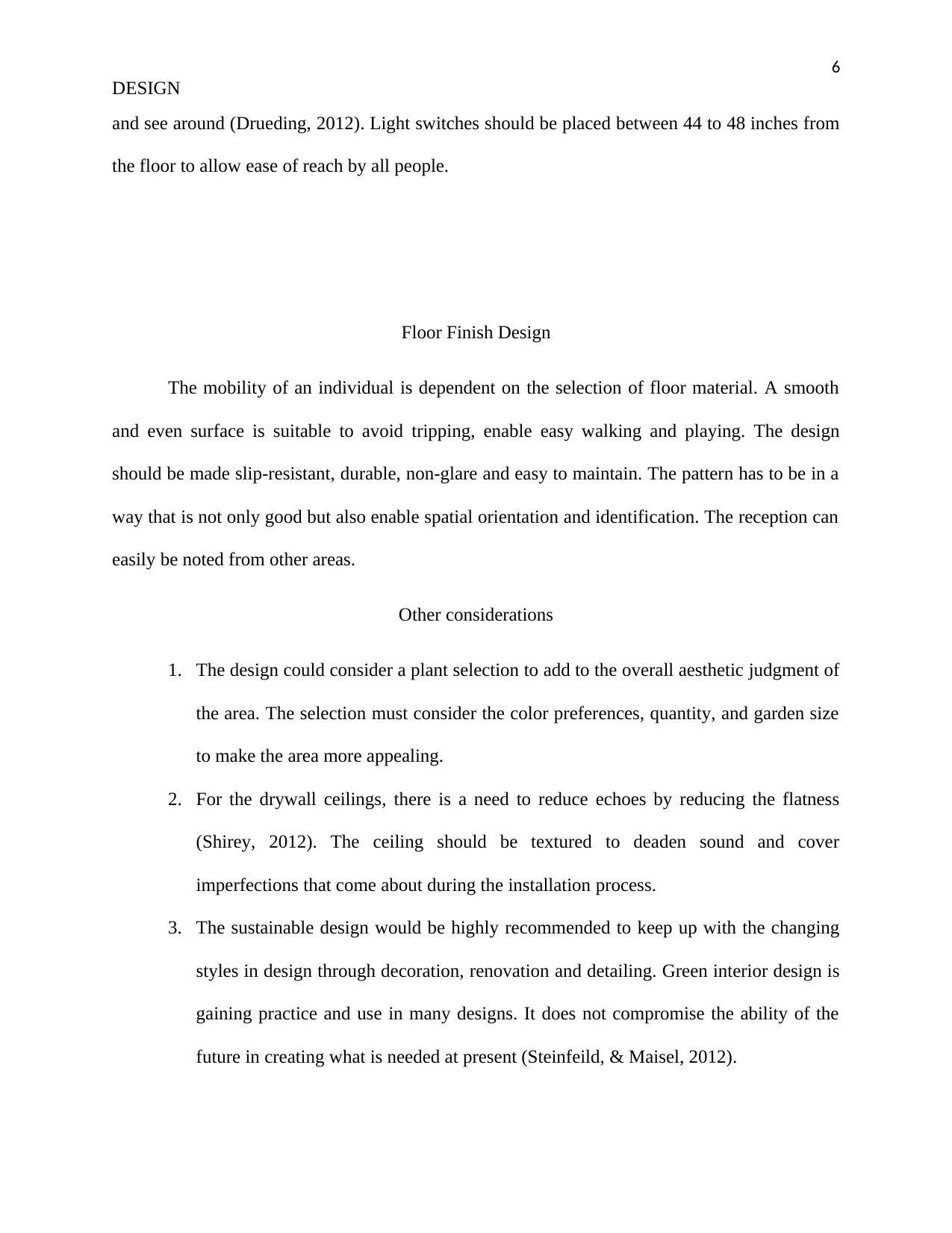
6
DESIGN
and see around (Drueding, 2012). Light switches should be placed between 44 to 48 inches from
the floor to allow ease of reach by all people.
Floor Finish Design
The mobility of an individual is dependent on the selection of floor material. A smooth
and even surface is suitable to avoid tripping, enable easy walking and playing. The design
should be made slip-resistant, durable, non-glare and easy to maintain. The pattern has to be in a
way that is not only good but also enable spatial orientation and identification. The reception can
easily be noted from other areas.
Other considerations
1. The design could consider a plant selection to add to the overall aesthetic judgment of
the area. The selection must consider the color preferences, quantity, and garden size
to make the area more appealing.
2. For the drywall ceilings, there is a need to reduce echoes by reducing the flatness
(Shirey, 2012). The ceiling should be textured to deaden sound and cover
imperfections that come about during the installation process.
3. The sustainable design would be highly recommended to keep up with the changing
styles in design through decoration, renovation and detailing. Green interior design is
gaining practice and use in many designs. It does not compromise the ability of the
future in creating what is needed at present (Steinfeild, & Maisel, 2012).
DESIGN
and see around (Drueding, 2012). Light switches should be placed between 44 to 48 inches from
the floor to allow ease of reach by all people.
Floor Finish Design
The mobility of an individual is dependent on the selection of floor material. A smooth
and even surface is suitable to avoid tripping, enable easy walking and playing. The design
should be made slip-resistant, durable, non-glare and easy to maintain. The pattern has to be in a
way that is not only good but also enable spatial orientation and identification. The reception can
easily be noted from other areas.
Other considerations
1. The design could consider a plant selection to add to the overall aesthetic judgment of
the area. The selection must consider the color preferences, quantity, and garden size
to make the area more appealing.
2. For the drywall ceilings, there is a need to reduce echoes by reducing the flatness
(Shirey, 2012). The ceiling should be textured to deaden sound and cover
imperfections that come about during the installation process.
3. The sustainable design would be highly recommended to keep up with the changing
styles in design through decoration, renovation and detailing. Green interior design is
gaining practice and use in many designs. It does not compromise the ability of the
future in creating what is needed at present (Steinfeild, & Maisel, 2012).
⊘ This is a preview!⊘
Do you want full access?
Subscribe today to unlock all pages.

Trusted by 1+ million students worldwide
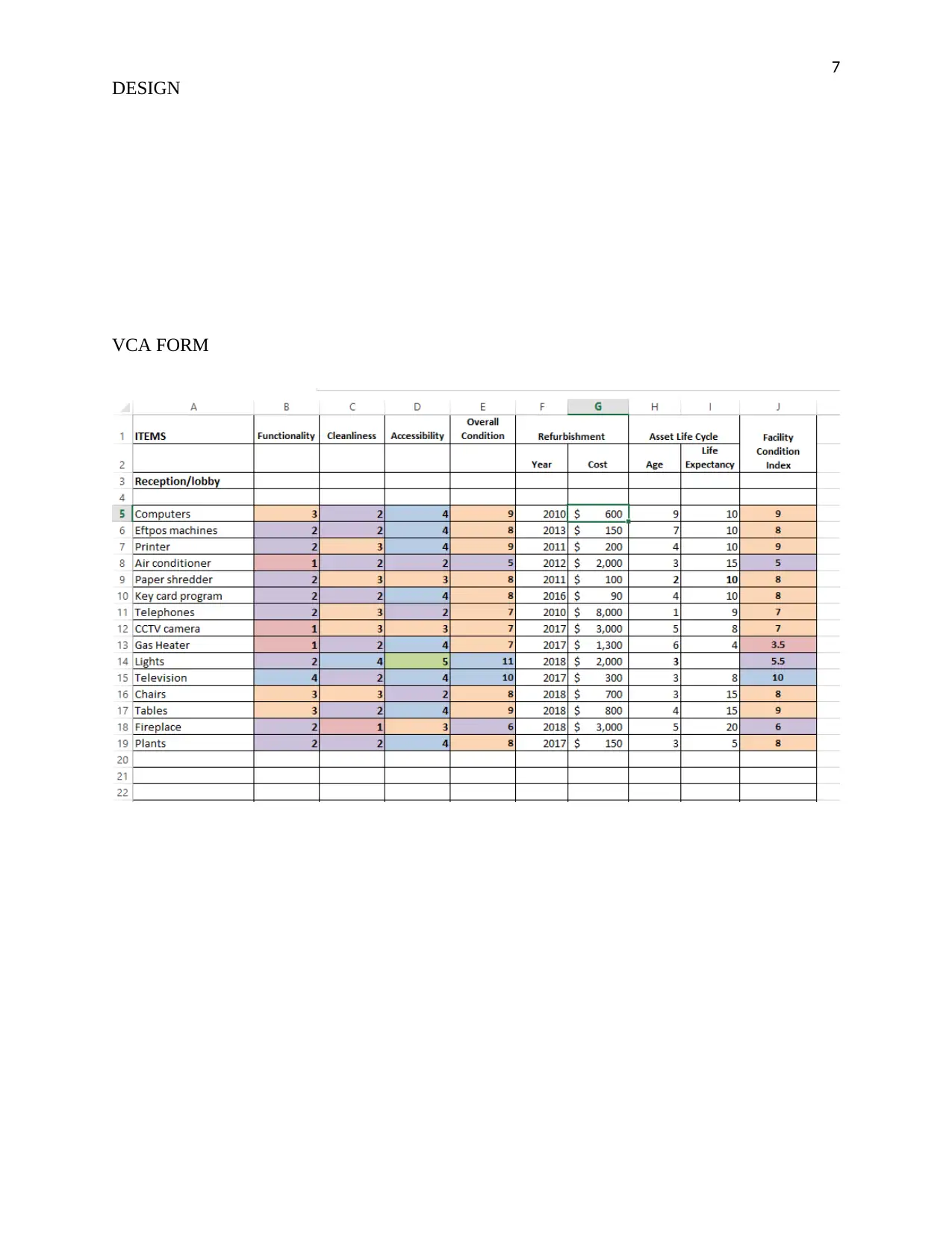
7
DESIGN
VCA FORM
DESIGN
VCA FORM
Paraphrase This Document
Need a fresh take? Get an instant paraphrase of this document with our AI Paraphraser
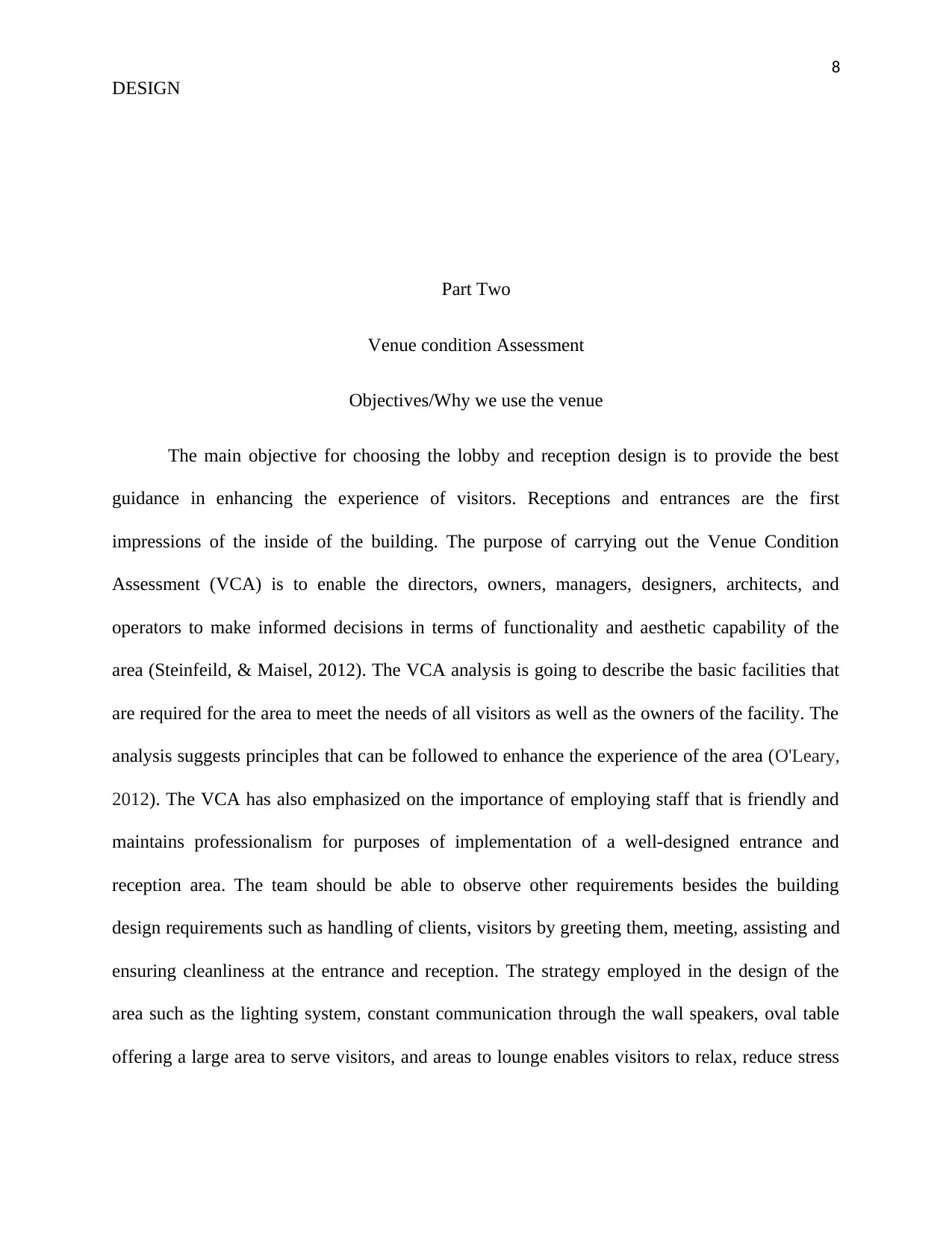
8
DESIGN
Part Two
Venue condition Assessment
Objectives/Why we use the venue
The main objective for choosing the lobby and reception design is to provide the best
guidance in enhancing the experience of visitors. Receptions and entrances are the first
impressions of the inside of the building. The purpose of carrying out the Venue Condition
Assessment (VCA) is to enable the directors, owners, managers, designers, architects, and
operators to make informed decisions in terms of functionality and aesthetic capability of the
area (Steinfeild, & Maisel, 2012). The VCA analysis is going to describe the basic facilities that
are required for the area to meet the needs of all visitors as well as the owners of the facility. The
analysis suggests principles that can be followed to enhance the experience of the area (O'Leary,
2012). The VCA has also emphasized on the importance of employing staff that is friendly and
maintains professionalism for purposes of implementation of a well-designed entrance and
reception area. The team should be able to observe other requirements besides the building
design requirements such as handling of clients, visitors by greeting them, meeting, assisting and
ensuring cleanliness at the entrance and reception. The strategy employed in the design of the
area such as the lighting system, constant communication through the wall speakers, oval table
offering a large area to serve visitors, and areas to lounge enables visitors to relax, reduce stress
DESIGN
Part Two
Venue condition Assessment
Objectives/Why we use the venue
The main objective for choosing the lobby and reception design is to provide the best
guidance in enhancing the experience of visitors. Receptions and entrances are the first
impressions of the inside of the building. The purpose of carrying out the Venue Condition
Assessment (VCA) is to enable the directors, owners, managers, designers, architects, and
operators to make informed decisions in terms of functionality and aesthetic capability of the
area (Steinfeild, & Maisel, 2012). The VCA analysis is going to describe the basic facilities that
are required for the area to meet the needs of all visitors as well as the owners of the facility. The
analysis suggests principles that can be followed to enhance the experience of the area (O'Leary,
2012). The VCA has also emphasized on the importance of employing staff that is friendly and
maintains professionalism for purposes of implementation of a well-designed entrance and
reception area. The team should be able to observe other requirements besides the building
design requirements such as handling of clients, visitors by greeting them, meeting, assisting and
ensuring cleanliness at the entrance and reception. The strategy employed in the design of the
area such as the lighting system, constant communication through the wall speakers, oval table
offering a large area to serve visitors, and areas to lounge enables visitors to relax, reduce stress
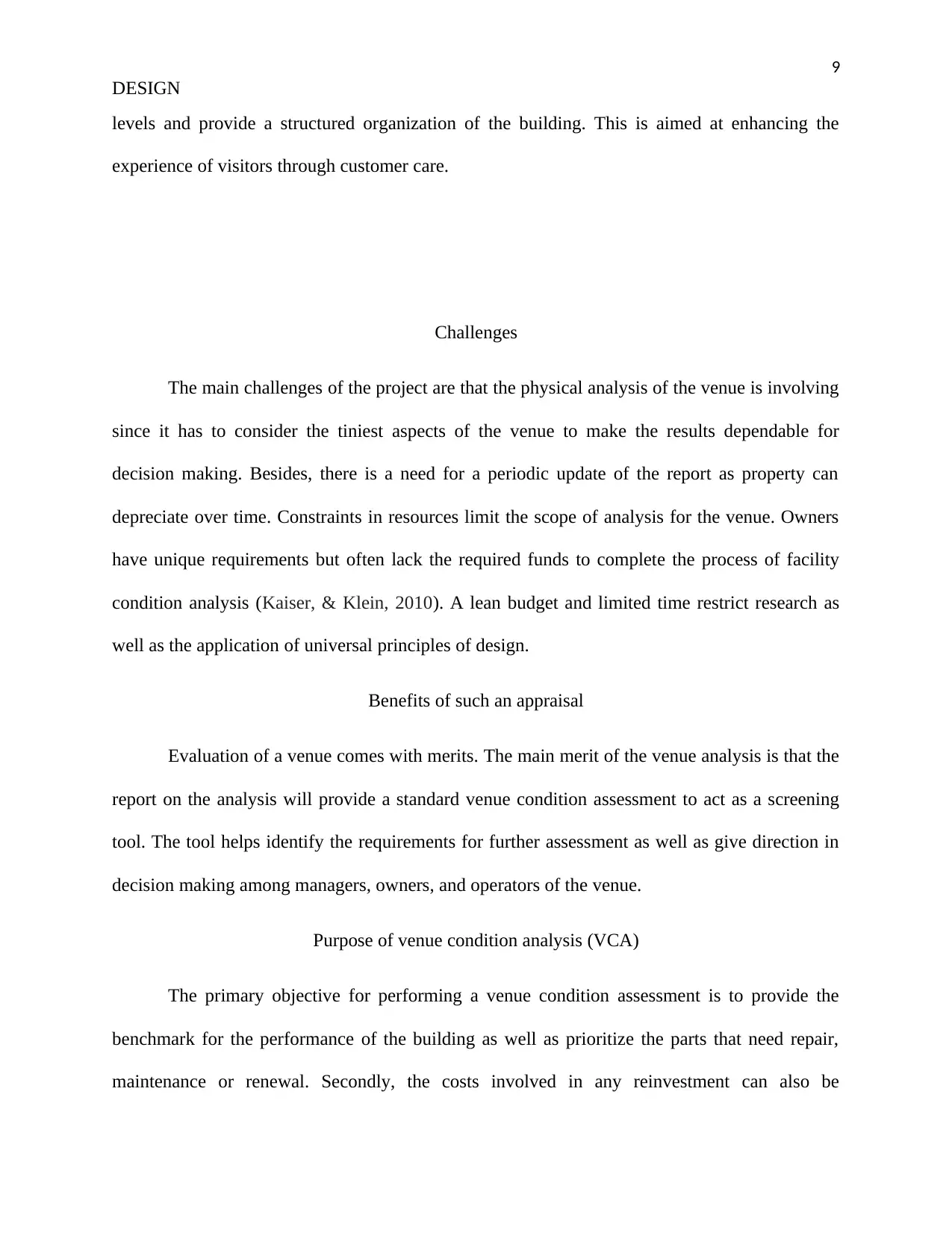
9
DESIGN
levels and provide a structured organization of the building. This is aimed at enhancing the
experience of visitors through customer care.
Challenges
The main challenges of the project are that the physical analysis of the venue is involving
since it has to consider the tiniest aspects of the venue to make the results dependable for
decision making. Besides, there is a need for a periodic update of the report as property can
depreciate over time. Constraints in resources limit the scope of analysis for the venue. Owners
have unique requirements but often lack the required funds to complete the process of facility
condition analysis (Kaiser, & Klein, 2010). A lean budget and limited time restrict research as
well as the application of universal principles of design.
Benefits of such an appraisal
Evaluation of a venue comes with merits. The main merit of the venue analysis is that the
report on the analysis will provide a standard venue condition assessment to act as a screening
tool. The tool helps identify the requirements for further assessment as well as give direction in
decision making among managers, owners, and operators of the venue.
Purpose of venue condition analysis (VCA)
The primary objective for performing a venue condition assessment is to provide the
benchmark for the performance of the building as well as prioritize the parts that need repair,
maintenance or renewal. Secondly, the costs involved in any reinvestment can also be
DESIGN
levels and provide a structured organization of the building. This is aimed at enhancing the
experience of visitors through customer care.
Challenges
The main challenges of the project are that the physical analysis of the venue is involving
since it has to consider the tiniest aspects of the venue to make the results dependable for
decision making. Besides, there is a need for a periodic update of the report as property can
depreciate over time. Constraints in resources limit the scope of analysis for the venue. Owners
have unique requirements but often lack the required funds to complete the process of facility
condition analysis (Kaiser, & Klein, 2010). A lean budget and limited time restrict research as
well as the application of universal principles of design.
Benefits of such an appraisal
Evaluation of a venue comes with merits. The main merit of the venue analysis is that the
report on the analysis will provide a standard venue condition assessment to act as a screening
tool. The tool helps identify the requirements for further assessment as well as give direction in
decision making among managers, owners, and operators of the venue.
Purpose of venue condition analysis (VCA)
The primary objective for performing a venue condition assessment is to provide the
benchmark for the performance of the building as well as prioritize the parts that need repair,
maintenance or renewal. Secondly, the costs involved in any reinvestment can also be
⊘ This is a preview!⊘
Do you want full access?
Subscribe today to unlock all pages.

Trusted by 1+ million students worldwide
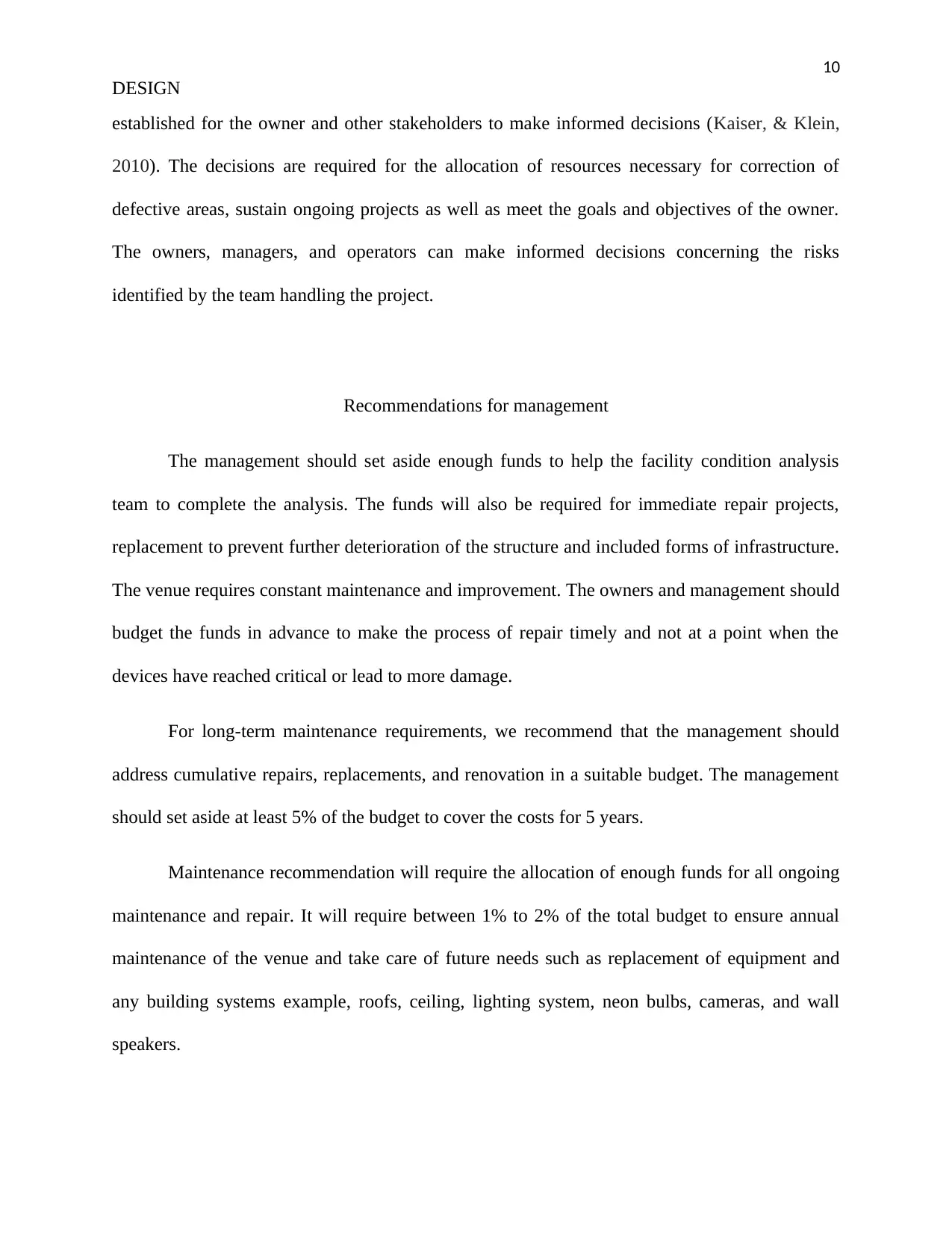
10
DESIGN
established for the owner and other stakeholders to make informed decisions (Kaiser, & Klein,
2010). The decisions are required for the allocation of resources necessary for correction of
defective areas, sustain ongoing projects as well as meet the goals and objectives of the owner.
The owners, managers, and operators can make informed decisions concerning the risks
identified by the team handling the project.
Recommendations for management
The management should set aside enough funds to help the facility condition analysis
team to complete the analysis. The funds will also be required for immediate repair projects,
replacement to prevent further deterioration of the structure and included forms of infrastructure.
The venue requires constant maintenance and improvement. The owners and management should
budget the funds in advance to make the process of repair timely and not at a point when the
devices have reached critical or lead to more damage.
For long-term maintenance requirements, we recommend that the management should
address cumulative repairs, replacements, and renovation in a suitable budget. The management
should set aside at least 5% of the budget to cover the costs for 5 years.
Maintenance recommendation will require the allocation of enough funds for all ongoing
maintenance and repair. It will require between 1% to 2% of the total budget to ensure annual
maintenance of the venue and take care of future needs such as replacement of equipment and
any building systems example, roofs, ceiling, lighting system, neon bulbs, cameras, and wall
speakers.
DESIGN
established for the owner and other stakeholders to make informed decisions (Kaiser, & Klein,
2010). The decisions are required for the allocation of resources necessary for correction of
defective areas, sustain ongoing projects as well as meet the goals and objectives of the owner.
The owners, managers, and operators can make informed decisions concerning the risks
identified by the team handling the project.
Recommendations for management
The management should set aside enough funds to help the facility condition analysis
team to complete the analysis. The funds will also be required for immediate repair projects,
replacement to prevent further deterioration of the structure and included forms of infrastructure.
The venue requires constant maintenance and improvement. The owners and management should
budget the funds in advance to make the process of repair timely and not at a point when the
devices have reached critical or lead to more damage.
For long-term maintenance requirements, we recommend that the management should
address cumulative repairs, replacements, and renovation in a suitable budget. The management
should set aside at least 5% of the budget to cover the costs for 5 years.
Maintenance recommendation will require the allocation of enough funds for all ongoing
maintenance and repair. It will require between 1% to 2% of the total budget to ensure annual
maintenance of the venue and take care of future needs such as replacement of equipment and
any building systems example, roofs, ceiling, lighting system, neon bulbs, cameras, and wall
speakers.
Paraphrase This Document
Need a fresh take? Get an instant paraphrase of this document with our AI Paraphraser
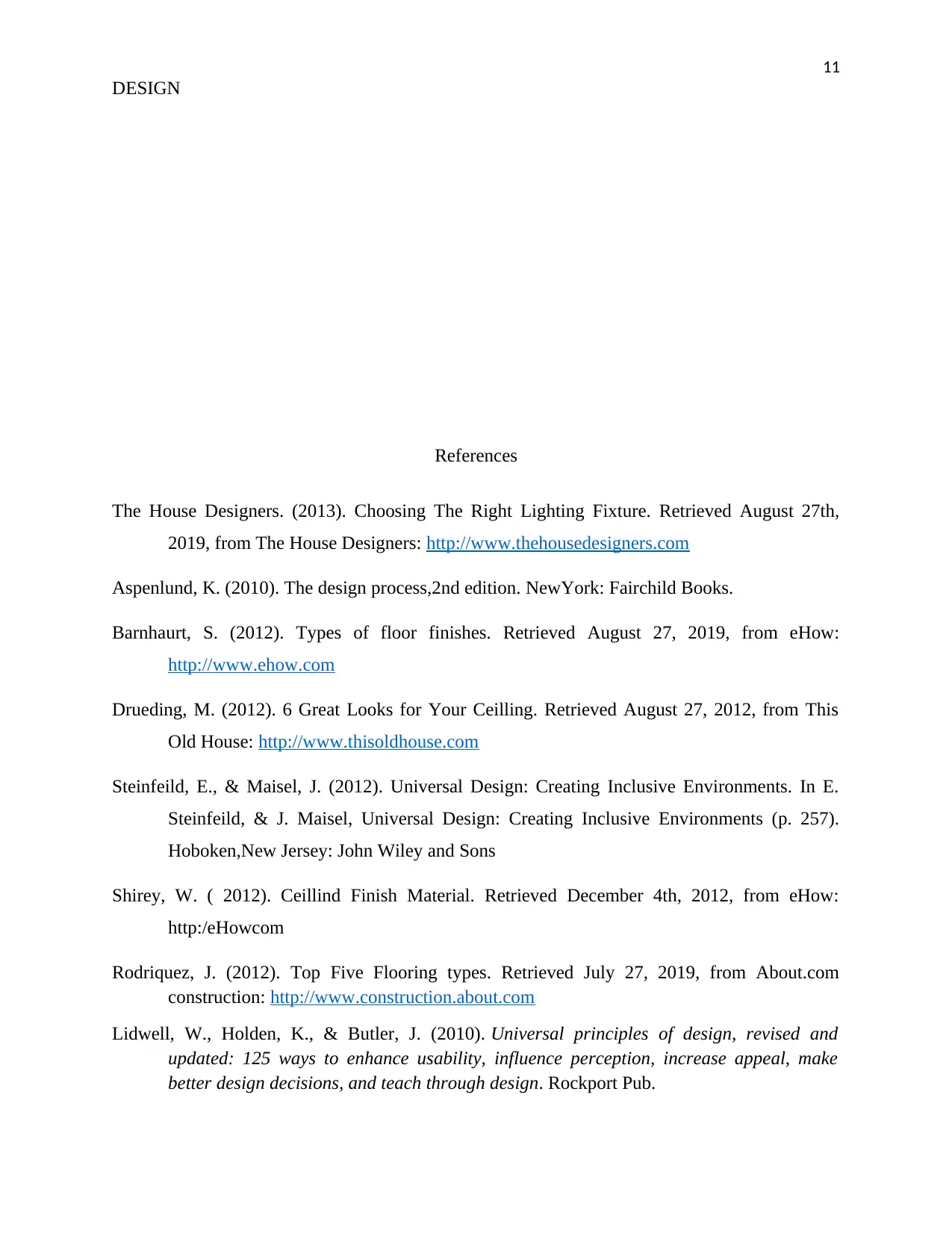
11
DESIGN
References
The House Designers. (2013). Choosing The Right Lighting Fixture. Retrieved August 27th,
2019, from The House Designers: http://www.thehousedesigners.com
Aspenlund, K. (2010). The design process,2nd edition. NewYork: Fairchild Books.
Barnhaurt, S. (2012). Types of floor finishes. Retrieved August 27, 2019, from eHow:
http://www.ehow.com
Drueding, M. (2012). 6 Great Looks for Your Ceilling. Retrieved August 27, 2012, from This
Old House: http://www.thisoldhouse.com
Steinfeild, E., & Maisel, J. (2012). Universal Design: Creating Inclusive Environments. In E.
Steinfeild, & J. Maisel, Universal Design: Creating Inclusive Environments (p. 257).
Hoboken,New Jersey: John Wiley and Sons
Shirey, W. ( 2012). Ceillind Finish Material. Retrieved December 4th, 2012, from eHow:
http:/eHowcom
Rodriquez, J. (2012). Top Five Flooring types. Retrieved July 27, 2019, from About.com
construction: http://www.construction.about.com
Lidwell, W., Holden, K., & Butler, J. (2010). Universal principles of design, revised and
updated: 125 ways to enhance usability, influence perception, increase appeal, make
better design decisions, and teach through design. Rockport Pub.
DESIGN
References
The House Designers. (2013). Choosing The Right Lighting Fixture. Retrieved August 27th,
2019, from The House Designers: http://www.thehousedesigners.com
Aspenlund, K. (2010). The design process,2nd edition. NewYork: Fairchild Books.
Barnhaurt, S. (2012). Types of floor finishes. Retrieved August 27, 2019, from eHow:
http://www.ehow.com
Drueding, M. (2012). 6 Great Looks for Your Ceilling. Retrieved August 27, 2012, from This
Old House: http://www.thisoldhouse.com
Steinfeild, E., & Maisel, J. (2012). Universal Design: Creating Inclusive Environments. In E.
Steinfeild, & J. Maisel, Universal Design: Creating Inclusive Environments (p. 257).
Hoboken,New Jersey: John Wiley and Sons
Shirey, W. ( 2012). Ceillind Finish Material. Retrieved December 4th, 2012, from eHow:
http:/eHowcom
Rodriquez, J. (2012). Top Five Flooring types. Retrieved July 27, 2019, from About.com
construction: http://www.construction.about.com
Lidwell, W., Holden, K., & Butler, J. (2010). Universal principles of design, revised and
updated: 125 ways to enhance usability, influence perception, increase appeal, make
better design decisions, and teach through design. Rockport Pub.
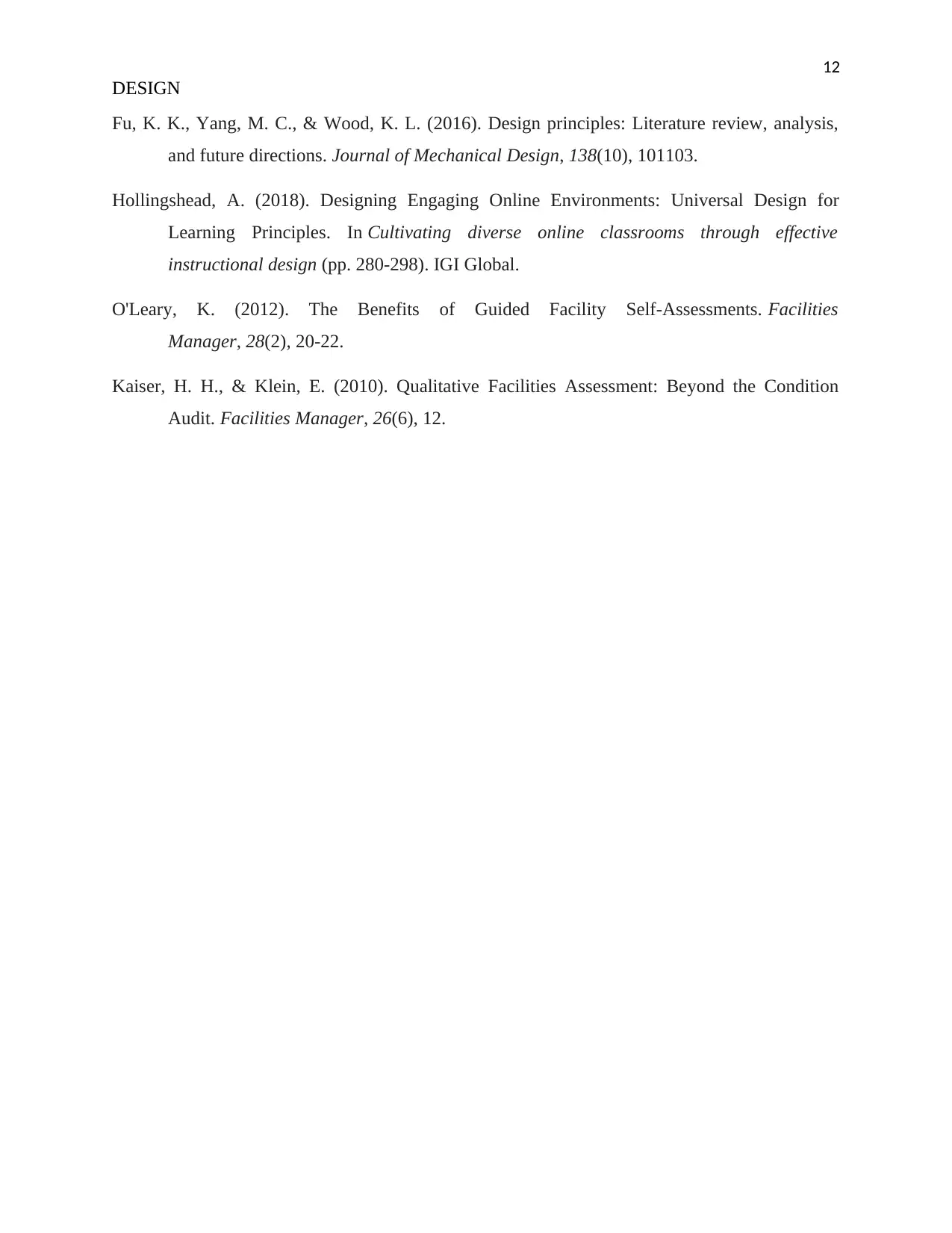
12
DESIGN
Fu, K. K., Yang, M. C., & Wood, K. L. (2016). Design principles: Literature review, analysis,
and future directions. Journal of Mechanical Design, 138(10), 101103.
Hollingshead, A. (2018). Designing Engaging Online Environments: Universal Design for
Learning Principles. In Cultivating diverse online classrooms through effective
instructional design (pp. 280-298). IGI Global.
O'Leary, K. (2012). The Benefits of Guided Facility Self-Assessments. Facilities
Manager, 28(2), 20-22.
Kaiser, H. H., & Klein, E. (2010). Qualitative Facilities Assessment: Beyond the Condition
Audit. Facilities Manager, 26(6), 12.
DESIGN
Fu, K. K., Yang, M. C., & Wood, K. L. (2016). Design principles: Literature review, analysis,
and future directions. Journal of Mechanical Design, 138(10), 101103.
Hollingshead, A. (2018). Designing Engaging Online Environments: Universal Design for
Learning Principles. In Cultivating diverse online classrooms through effective
instructional design (pp. 280-298). IGI Global.
O'Leary, K. (2012). The Benefits of Guided Facility Self-Assessments. Facilities
Manager, 28(2), 20-22.
Kaiser, H. H., & Klein, E. (2010). Qualitative Facilities Assessment: Beyond the Condition
Audit. Facilities Manager, 26(6), 12.
⊘ This is a preview!⊘
Do you want full access?
Subscribe today to unlock all pages.

Trusted by 1+ million students worldwide
1 out of 12
Related Documents
Your All-in-One AI-Powered Toolkit for Academic Success.
+13062052269
info@desklib.com
Available 24*7 on WhatsApp / Email
![[object Object]](/_next/static/media/star-bottom.7253800d.svg)
Unlock your academic potential
Copyright © 2020–2025 A2Z Services. All Rights Reserved. Developed and managed by ZUCOL.





